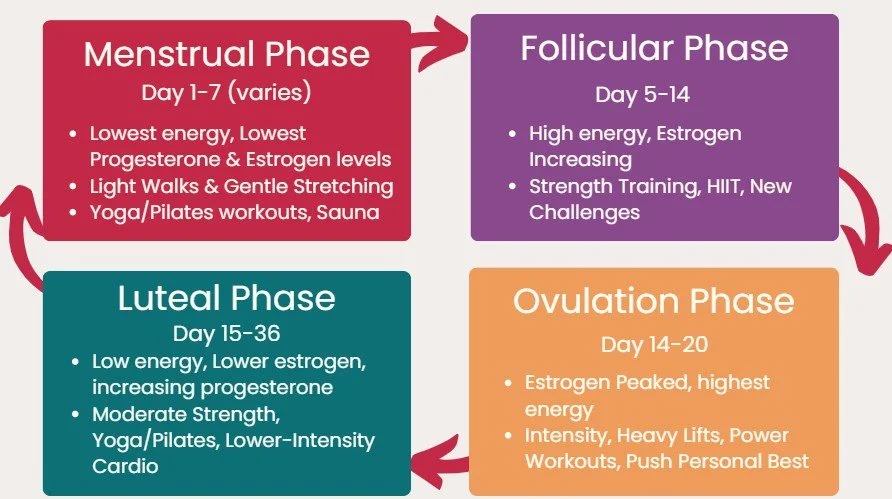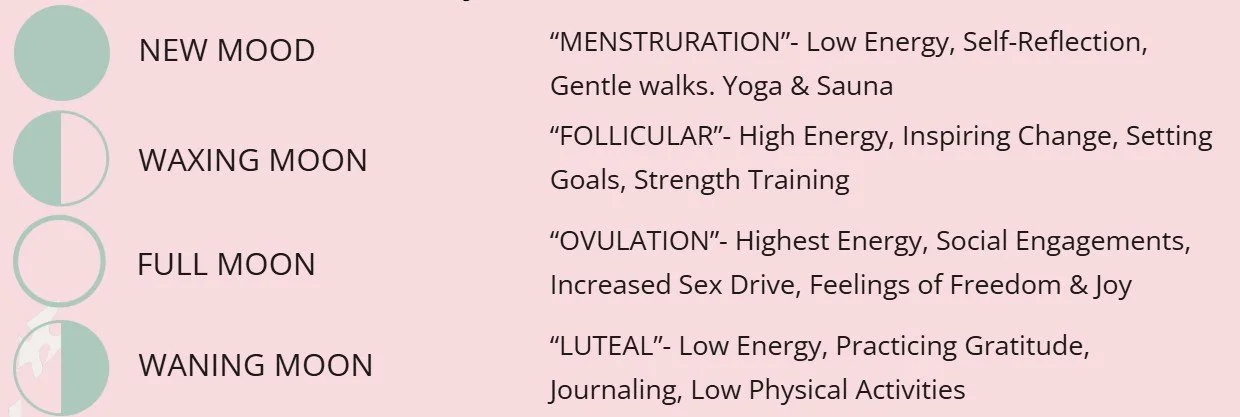Unlocking The Power of Your Cycle
Jul 29
If you menstruate, you’ve probably noticed that your energy, mood, and performance shift throughout the month. One week you feel unstoppable, the next you're wiped out by cramps or mood swings. It’s tempting to get frustrated—but what if, instead of fighting your body, you learned to flow with it?
Your cycle isn’t a flaw to be fixed. It’s a built-in rhythm—one that’s rich with insight about your stress levels, hormonal balance, nutrition, and nervous system health. The more you understand it, the more you can use it as a tool to optimize everything from your workouts to your mental clarity.
Let’s start with what’s really happening behind the scenes.
Your cycle is influenced not only by the current moment but by the last three months of your life. It takes about 90 days for an egg to fully mature before ovulation. That means your period this month may be your body’s response to stress, illness, or poor sleep from months ago. This also explains why it can take at least three full cycles to notice meaningful change when you make lifestyle shifts or start a new intervention.
Chronic stress, poor sleep, gut infections, inflammation, trauma, and nutrient deficiencies all play a role in egg quality and cycle regularity. If you’ve been under prolonged stress—or if your body hasn’t felt truly safe in a long time—it’s not uncommon for your cycle to become painful, irregular, or even go missing. Myth buster, your ovaries don’t take turns releasing, so you can’t blame one ovary for all your bad periods. The truth is, one ovary might ovulate several times in a row, and sometimes both release an egg—hello, fraternal twins.
Understanding your bleed is also key. Not all bleeding is a true period.
A real menstrual period only occurs after ovulation. So what happens during this part of your cycle is Estrogen rises, thickening the uterine lining; then ovulation triggers a surge of luteinizing hormone (LH), releasing one egg. After this release, progesterone rises to prepare for pregnancy. If no pregnancy occurs, hormone levels drop and menstruation begins. That’s a real cycle.
But if you’re on hormonal birth control—especially the pill—you’re not actually ovulating. The “monthly bleed” you experience is called a “withdrawal bleed”, and this is triggered by the sudden drop in synthetic hormones during the placebo week. Fun fact: this synthetic trigger was actually added intentionally in the 1960s to mimic a period. This is called the “placebo week” and was added to make the pill feel more “natural.” So moral of the story is if you’re not ovulating, that bleeding isn’t a true period—it’s just your body responding to the absence of synthetic hormones.
Other times, bleeding may happen because of hormone imbalances, like estrogen dominance or low progesterone. This kind of bleeding can be common in PCOS, postpartum, or during hypothalamic dysfunction—when the body downregulates hormone production due to stress or energy deficits.
Why does this matter?
Because your cycle is your body’s monthly report card. It offers real-time feedback on how you’re doing—physically, emotionally, hormonally. When you learn to read it, you can finally stop guessing and start living in sync with your body’s wisdom.
Your menstrual cycle moves through four main phases—each with unique hormone patterns, mood shifts, and energy changes. Syncing your lifestyle with these phases is one of the most powerful things you can do to feel better, perform better, and connect more deeply with your body.
Working With The Phases of Your Cycle
During menstruation—think of this as your “inner winter” season—your hormones are at their lowest. You may feel more sensitive, introspective, or tired. It’s a time for rest, reflection, and nourishment. Focus on iron-rich foods, vitamin C, and omega-3s. Gentle movement like stretching, walks, or sauna can support circulation without draining your system.
As you move into the follicular phase— think of this as “spring” season—estrogen rises and so does your energy. This is a great time to try new things, start projects, or increase training intensity. Your body thrives on fiber, protein, and fermented foods here to support hormone production and detox.
Ovulation is your “summer” season—estrogen peaks and you likely feel your most magnetic, social, and confident. This is the best time for your most intense workouts, big meetings, or creative bursts. Support this phase with magnesium, antioxidants, and omega-3s from foods like salmon, seeds, and leafy greens.
The luteal phase is your “fall” season. Progesterone rises, energy slows, and your mood might dip. This is a time to simplify, ground yourself, and turn inward. Support your body with B vitamins, potassium, and magnesium. Think comfort foods with a nourishing twist—avocados, sweet potatoes, and healthy fats.
What About Menopause?
Even if you’re not menstruating—due to menopause, postpartum, or hormonal imbalance—you can still create rhythm by syncing your energy to the phases of the moon. Many people find stability and connection in aligning their rest, movement, and creativity to the lunar phases as a stand-in for their cycle.
And your period blood? It speaks volumes. Bright red blood with a smooth, syrupy consistency generally signals a healthy balance of estrogen and progesterone. Brown blood is old, oxidized blood that may indicate low progesterone or sluggish uterine circulation. Pink blood could mean low estrogen or nutrient deficiencies, especially if you’re not getting enough protein or iron. Dark purple blood with clots can be a sign of estrogen dominance—often paired with heavy flow, bloating, breast tenderness, and mood swings.
Oh Yes, Chiropractic Can Help!
This is where nervous system health comes back into the picture. Hormonal balance doesn’t start in your ovaries—it starts in your brain. Ovulation begins when your hypothalamus signals your pituitary gland to release FSH and LH. That signal depends on safety, nourishment, and nervous system regulation.
If your brain doesn’t feel safe, your body will press pause on reproduction. That’s why chiropractic care, trauma-informed therapy, nervous system support, and mindfulness practices can be powerful tools for restoring ovulation and healthy cycles. It’s also why functional medicine testing can be a game changer. Don’t guess—test. Looking at your hormones, nutrient levels, gut health, or even cortisol patterns can help uncover the root causes behind irregular cycles, PMS, or fatigue and guide more precise support.
Things You Can Do
Supporting your hormones also means supporting your nutrition. Animal protein tends to be more bioavailable and rich in the building blocks for hormone production: essential amino acids, cholesterol, B12, zinc, and iron. While plant-based diets can absolutely work, they often require more careful planning and supplementation to meet hormonal needs.
And don’t forget your period products—many conventional pads and tampons contain toxic materials that disrupt your hormones. Choose organic, non-toxic options when possible. For cramps and PMS, nutrients like magnesium, turmeric, ginger, and raspberry leaf can help ease symptoms—but they work best when used consistently.
Above all, track your cycle. Whether you’re trying to conceive, manage PMS, or simply reconnect with your body, tools like basal body temperature, cervical mucus monitoring, or LH strips give you powerful insight into your hormone health and ovulation patterns.
Your body isn’t unpredictable—it’s cyclical. When you learn to listen, you unlock a roadmap to better energy, more confidence, and deeper resilience.
Ovulation begins in the brain. Healing begins with awareness. Start syncing with your cycle—and watch your power return.



